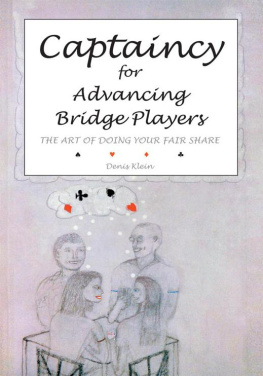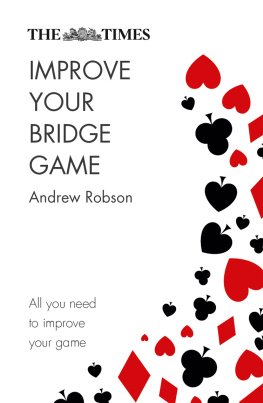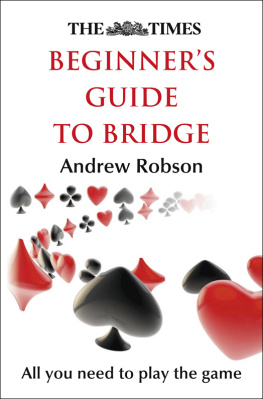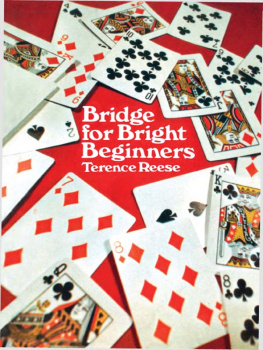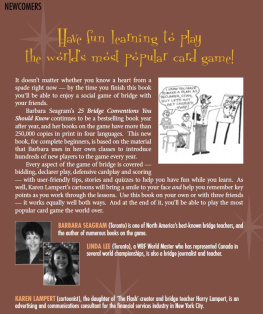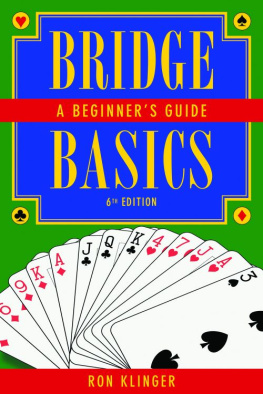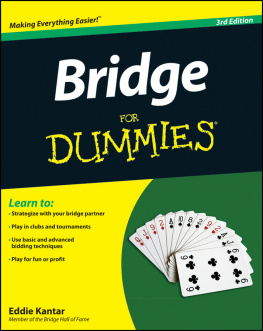Captaincy for
Advancing Bridge Players
Denis Klein
Copyright 2006 Denis Klein.
All rights reserved. No part of this publication may be reproduced, stored in a retrieval system, or transmitted, in any form or by any means, electronic, mechanical, photocopying, recording, or otherwise, without the written prior permission of the author.
Note for Librarians: A cataloguing record for this book is available from Library and Archives Canada at www.collectionscanada.ca/amicus/index-e.html ISBN 1-4120-2986-4

Offices in Canada, USA, Ireland and UK
Book sales for North America and international:
Trafford Publishing, 6E2333 Government St., Victoria, BC V8T 4P4 CANADA phone 250 383 6864 (toll-free 1 888 232 4444) fax 250 383 6804; email to Book sales in Europe:
Trafford Publishing (UK) Limited, 9 Park End Street, 2nd Floor Oxford, UK OX1 1HH UNITED KINGDOM phone 44 (0)1865 722 113 (local rate 0845 230 9601) facsimile 44 (0)1865 722 868;
Order online at: trafford.com/04-0813
Contents
Captaincy for Advancing Bridge Players
or
The Art of Doing Your Fair Share
Denis Klein
*
People can be defined
by the choices they choose to make,
so too a Bridge partner.
*
You the reader have no doubt heard the classic statement, Bridge is a partnership game. What are the ramifications of that simple sounding phraseof that clich? What does it actually mean? And what are the inherent responsibilities facing the developing Advancing Bridge player, who desires to become a more complete and accomplished partner? Pragmatically, what partnership abilities increase your chances of winning?
An umbrella concept called Captaincy is proposed, that seeks to address the above fundamental questions by bringing into focus how both theory and practice must contribute to what is meant by partnership. Captaincy intersects so many central aspects of Bridge, that you will come to appreciate the crucial role it must play in improving your bidding and defensive skills. Initial lists of broad Concepts provide direction for how partners will want to view the context of their auctions and defenses, if they wish to maximize their actual results at the table.
From the bidding we have classic issues such as the need to communicate distribution and strength to partnerwhile wanting to disrupt the opponents ability to do likewise; and how and why these topics are guided by Captaincy Concepts. Also, how fundamental bidding choices such as the final contracts level and strain, are directed by Captaincy considerations as well.
Captaincy then links what has transpired during the bidding, to the conscious choices defenders must considerchoices not only at the opening lead but beyond as well. A defender must determine whether to engage in either an active and/or passive style of defense; then as a pair translate this plan into action, or alter it as conditions change.
The reader will soon appreciate that the Captaincy perspective leads us in numerous fascinating directions. For one, towards a shift away from the classic approach of how defensive signals are generally taught when we first learn the game. Rather than viewing individual holdings in one particular suit in isolation, there is an advantage to learning a perspective that combines both the current desires of an individual player, viewed from the context of the broader hand as a whole. Too often, even when Advancing players defensive skills develop, they may incorporate one of these halves but not both. This is most usually made painfully evident when the defenders find themselves in a delicate (usually active) defensive situation, and cash their tricks in the wrong order thereby losing tricks.
Although defensive skills improve over time in direct relationship to each individual players technical ability level, Bridge theory should provide more of a continuous framework for its development. Building from the rudimentary single-suit perspective to a more hand-comprehensive one, is often presented in the Bridge literature as a discontinuous process where the defender must break from previously learned practices. (You see a question raised such as, Should a defender always high/low with a doubleton?, for instance.) This demonstrates a limitation in present Bridge theory, which makes it more difficult for less experienced players to advance their defensive skills. Captaincy helps provide a broader conceptual framework that underlies what the intent of signaling simply is. Whether we can accomplish this in a particular situation with the cards we are dealt, is the trick, so to speak.
Captaincy infiltrates other fundamental areas as well. For instance, it is fairly common in the Bridge literature to discuss Declarer play in terms of Safety Plays (How many tricks does Declarer need in a particular suit and what is the best way to safeguard getting at least that number?), combining chances (to maximize the probability of a favorable result by exploring chances in multiple suits), and playing tricks in a proper order (to maximize chances and reduce the defenders options). As players Declarer skills mature, they become much stronger in these areas.
Similarly, following logical threads, Captaincy leads us directly into the perspective that analogous defender
actions can and should be used to the advantage of the defenders. Thus we find ourselves in discussions that are normally reserved for Declarer play in the literatureof combining chances and the proper order of cashing tricks.
A new trick target and defensive card combination conceptual term called Tailoring Plays is proposed, that subsumes the more common defensive plays such as Unblocking and Surround Plays. Through one type of Tailoring Play, defenders seek to maximize their chances to achieve a particular trick target total, as Safety Plays seek to accomplish this for Declarers. In this way, the theory of Declarer play and defensive play become more like reflecting pools of one anotherdiametrically opposed but having the same options available to them. The former accomplished by one Declarer; the latter guided by Captaincy theoryaccomplished by two defenders as they strive towards a particular trick target together.
The above areas are just a few of the profound, interesting, and pragmatic outgrowths resulting from Captaincy theory
as discussed within these pages.
*
Good Bridge players dislike having to guess when faced with decisions. How do they seek to minimize guessing and either gather or provide as much information on a given hand, whether they find themselves bidding or defending? To Flight B or C players, it is fairly obvious that experts are extremely proficient within such areas as their technical skills, analysis, and the development of partnership understandings. But it is within the broad areas of Captaincy where the above skill-sets are applied, that non-experts often have more significant blind spots. They seem to be much less aware of how experts seek to help each other, and the ways experts communicate timely information. Consequently, the development of Captaincy skills seems to lag significantly and disproportionately, between experts and Flight B players who have played the game for years. That said, all levels of players do naturally make Captaincy errors or can miss Captaincy opportunities. Be aware that 100% of the available Captaincy opportunities can never be created (or found) even by experts, as Bridge contains not only science but art as wellthe aspects of both the science and the art of Bridge that your partnerships are able to utilize, are partially dependent upon the methods you agree (choose) to employ.
Next page
